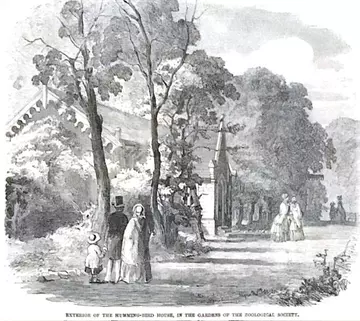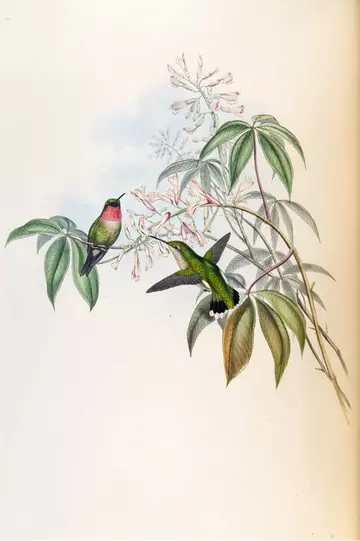![John Gould in the Ipswich Portraits by T.H. Maguire [1849-51]](https://cms.zsl.org/sites/default/files/styles/360w/public/2023-07/John%20Gould%20in%20the%20Ipswich%20Portraits%20-%20T.H.%20Maguire.png.webp?itok=Y3nWA8YR)
Ann Sylph, MSc, MCLIP
ZSL Librarian
This is a guest blog by Ann Datta, Volunteer Art Cataloguer at ZSL Library and Archives.
Gould’s Hummingbird’s at the Zoological Society 1851.
In May 1851, 170 years ago, the Gardens of the Zoological Society of London (now named London Zoo) hosted a remarkable exhibition of hummingbirds. The hummingbirds were not living, of course, but their tiny bodies had been stuffed and arranged decoratively among exotic foliage and flowers in glass cases, as imagined in nature in the Americas by their creator and owner, the English ornithologist John Gould (1804-1881).
![John Gould in the Ipswich Portraits by T.H. Maguire [1849-51]](https://cms.zsl.org/sites/default/files/styles/360w/public/2023-07/John%20Gould%20in%20the%20Ipswich%20Portraits%20-%20T.H.%20Maguire.png.webp?itok=Y3nWA8YR)
The exhibition was held in a temporary building specially put up at Gould’s expense near the then Lion House. The Hummingbird House measured 60x30 feet (20x10 metres) and was surrounded by shrubbery.

Inside were 24 plate-glass display cases arranged in rows. Each case, of either four or six glass sides and a glass top, rested on a carved wooden base painted black and gold, supported on stands that raised the cases to eye-level, and enclosed within a low barrier: the innovative all-glass construction allowed visitors to walk around the cases and see the birds from all angles. Each display case measured approximately 65cm high x 55cm wide and was labelled with the scientific names of the birds displayed. A canopy was suspended on poles above the cases and curtains were draped from the ceiling to give the room an air of elegance. A row of upholstered seats ran along the panelled walls hung with pictures.

1,500 stuffed hummingbirds were exhibited, supported on fine wires, and arranged so that the characteristic iridescent red, blue, green and purple colours of the feathers of the male birds caught the light and showed them off to advantage. Under the terms negotiated between Gould and the Society he charged visitors to the exhibition 6d on Mondays and one shilling on the remaining weekdays. Fellows of the Society and two friends were admitted free, and it was also free on Sundays. The Hummingbird exhibition attracted over 75,000 visitors, including Queen Victoria and many eminent scientists, in 1851. Receipts for 17 May (when the exhibition opened) to 8 November 1851 record entry takings of £1,589.15 (£225,000 today). Initially, Gould had intended to hold the exhibition for six months from May until November 1851 but such was its success that the Society granted it an extension into 1852 after which admission tickets to the Gardens included entry to the Hummingbird Exhibition too.
Gould and the Zoological Society
By 1851 Gould had been closely associated with the Zoological Society for 20 years. He had come a long way since he joined the staff in 1828 as curator and preserver, when the Society had a Museum, and had left it in 1837 to explore the zoology of Australia. Now, through his research and large colour plate bird books, Gould was the best-known ornithologist in Britain. He still carried on his taxidermy practice in Soho where he lived but his reputation depended on scientific publications which earned him fellowship of the Zoological and Royal Societies. It is, therefore, a mystery why Gould should choose to put on a major display of stuffed birds at this stage in his career, more showman than scientist, something which he had never done before or after. It is possible that Gould was inspired by the euphoria surrounding preparations for the Great Exhibition which opened on 1 May 1851 and wanted to be part of it. This idea may have coincided with a surplus of hummingbirds crowding his premises. Huge numbers of hummingbirds now flooded into London from South America, and many consignments arrived at Gould’s house to be sorted for new species leaving him with many birds that lacked documentation, were duplicates or imperfect and unable to be sold. By using hundreds of these birds in a masterly exhibition that matched the theme of the Great Exhibition, Gould found a use for the spare birds that also earned him favourable publicity and profitable gate takings.

Gould’s Hummingbirds at the Natural History Museum 1881
When the exhibition finally closed in 1852 Gould took the display cases back to his house. The Hummingbird House was converted into a Parrot House for the Society’s use. Throughout his life Gould was obsessed with hummingbirds: he made it his mission to collect every species and his private collection far exceeded that of the national collection. Today, an estimated 350 species of hummingbirds are recognised in the family Trochilidae, approximately the same number that Gould would eventually describe and illustrate in his Monograph of the Trochilidae
(1849-1861). After Gould’s death in 1881 the British Museum purchased all the hummingbird display cases and the unmounted hummingbird skins. These, together with Gould’s other bird collection, cost it £3,000 (today equivalent to about £367,175).
The 24 display cases exhibited at the Society in 1851 had grown to more than 60 by the time Gould died. 30 years after Gould had collected his hummingbird cases from the Zoological Gardens the same cases were put on public display in galleries in the new Natural History Museum in South Kensington which opened in 1881. The Museum published an accompanying Guide and the hummingbirds were a popular exhibit until a WW2 bomb fell on the Museum damaging some cases. Today, only six cases survive intact in the Natural History Museum. Though the colours of the hummingbirds are somewhat faded, they remain important historic examples of Gould’s taxidermy and artistic vision 170 years ago.

Search our online Library catalogue
Ann Datta is the author of a book about John Gould 'John Gould in Australia: letters and drawings' Victoria: The Miegunyah Press, 1997. She also co-authored with Andrea Hart 'Birds of the world: the art of Elizabeth Gould' Munich, London: Prestel, 2023. Both books can be found in ZSL Library and Archives.
The lesser bird of paradise and other animals in the Reeves album of early nineteenth-century watercolours is one of the gems of Chinese natural history art.
